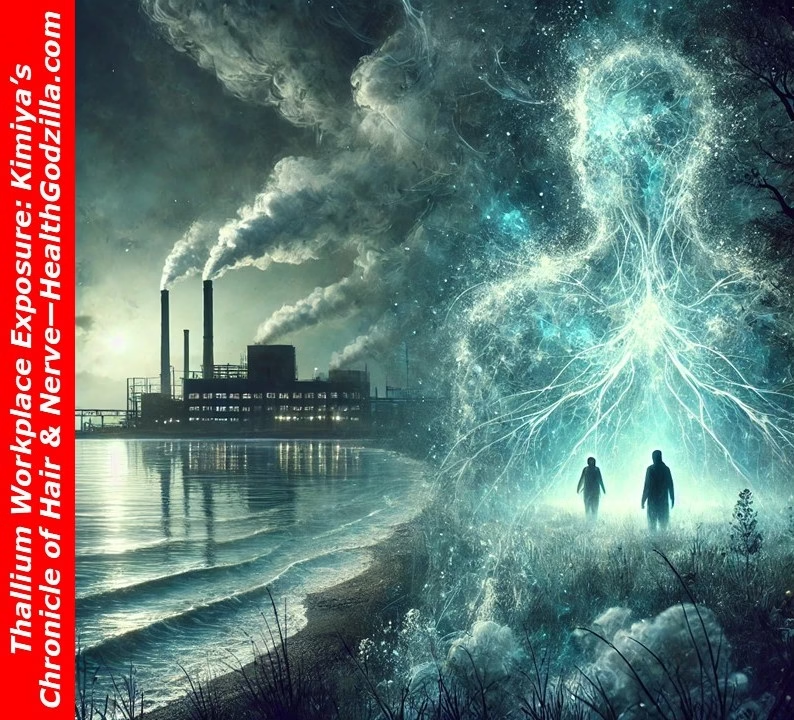
Kimiya’s First Memory of Thallium
It came to Kimiya not as a name, but as a color — a sudden green flame in a Victorian laboratory, which was the telltale signature that marked thallium’s discovery. Initially, it was a curiosity, a flicker caught in a spectroscope. However, metals have a way of changing masks. In this chronicle of hair and nerve, thallium workplace exposure would prove to be no relic of history.
Subsequently, Kimiya saw its other lives unfold: the silent killer in rodent baits, the misguided remedy in specific medical tinctures, and the hidden impurity in ores that found their way into smelters and glassworks. In each life, it stayed the same — odorless, tasteless, and almost impossible to sense until it was too late.
As centuries blurred, Kimiya stood in the chemical plants of the mid-20th century, where thallium salts were handled bare-handed, and in the coal-fired power stations where their vapors drifted up chimneys, settling quietly into soil and lungs. Ultimately, each place left a trace. Furthermore, each trace left
From Furnace to Fingertips — How Thallium Moves
In the present day, thallium workplace exposure still walks factory floors, though it leaves no footprint.
From molten metal in copper smelters, it drifts into the air; in cement kilns, it hides in the dust; in glass production, it slips from pigments. It can even ride the exhaust of coal combustion, settling far beyond the gates of the plant.
Once released, it enters the body without ceremony:
Inhalation — fine particles breathed deep into the alveoli.
Dermal absorption — powders clinging to sweat, slipping past the skin’s barrier.
Ingestion — dust transferred from unwashed hands to food, to mouth, to gut.
Once inside, it moves quickly into the blood — binding to tissues as if it had always belonged there.
Forensic Proof in Hair & Nails
If the air and dust are the crime scene, hair and nails are the archive.
Thallium workplace exposure can be read in keratin, each millimeter a dated entry in a slow-unfolding log. Hair analysis can reveal exposures from months past, offering both medical insight and legal evidence.
A strand tells the story in sequence: the root nearest the scalp records the most recent weeks; the tip holds older history. Nails speak too, their growth pushing the metal outward, like a secret eventually surfacing. Forensic toxicologists know this well — in thallium cases, hair and nails often speak louder than blood, which clears more quickly.
To Kimiya, these were not just tests, but testimony — proof that even if the air had changed, the body still remembered.
Workplace Case Studies & Lessons
Some stories came to Kimiya in fragments — a headline here, a whispered recollection there — but thallium workplace exposure cases were rarely whole until they reached the quiet pages of an investigation file.
In a cement plant, sweeping at day’s end sent shimmering dust into the air. Months later, workers shared the same strange hair loss, the same pins-and-needles in their limbs. Diagnosis: thallium poisoning.
In a glass works, thallium salts were the ingredient that gave a deep green glow. Bare hands sifted the powders. One worker’s nails became the ledger — rising thallium levels segment by segment.
At a refinery, imported ores carried thallium inside. The furnaces freed it into air and dust that settled beyond the gates. The air samples said “within limits.” The workers’ bodies told another story.
The lessons were not new: monitor the air before the lungs take it in, respect thresholds nature sets, and understand that some metals outlast denial. Kimiya wrote them not for companies, but for workers who might read the signs in time.
Regulatory Gaps & the Illusion of Safety
Regulations spoke in numbers — permissible limits, tolerance values — suggesting control. But some nations had no specific limit for thallium. Others relied on outdated figures, designed to prevent acute poisoning but silent on slow nerve damage or hair loss.
Compliance could be performed like theater: testing on low-production days, placing samplers far from true sources. “Within limits” could be a legal truth and a human falsehood.
In poorer nations, thallium workplace exposure crossed borders unmarked, embedded in ores or products, invisible to customs inspections. Harms were exported with the raw materials; illnesses imported with the goods.
Kimiya knew that the body’s record often contradicted the law’s — and when they clashed, it was the flesh, not the paper, that told the truth.
Kimiya’s Closing Passage — The Metal That Waits
There are metals that sing when struck, and metals that shine when polished.
Thallium does neither. It waits.
In the seam of ore pulled from a mountain, it waits.
Dust on a factory floor can cradle it for years.
And in the blood of a worker who has never heard its name, it hides still.
Hair and nails will keep the memory.
So will the nerves and the slow rhythm of the heart.
Kimiya knew — the danger lay not just in the metal’s patience, but in our own. Regulations could pause, enforcement could falter, awareness could fade. But the metal would not.
And somewhere beyond the gates, a worker’s hand might tremble, and no one would yet know why?
🍂 Hello, Artista

The rain had been falling all morning in Vancouver, fine as silk threads, beading on Whitee’s fur while Brownie watched from under the porch. Artista stood at the window, tea cooling in her hand.
On the other side of the call, Organum’s voice came through with the scratchy warmth of an old line from Boston.
“You read Kimiya’s account?”
“I did,” Artista said. “It feels like a warning written in invisible ink — you only see it when the light hits a certain way.”
Organum chuckled softly. “Or when the hair begins to fall. Or the nerves begin to forget their work.”
They let the silence sit. Outside Artista’s window, the rain kept writing its own unending lines down the glass.
“I keep thinking about patience,” she said finally. “Not the kind we praise in people. The patience of things that wait for harm to happen. The patience of dust.”
“Rigid things crack,” Organum murmured, “but roots learn to weave around stone. Maybe our job is to help the roots.”
Artista imagined Whitee and Brownie nosing at the wet earth, each step a small disturbance of the ground. “Do you think,” she asked, “that if people could see thallium the way they see rain, they’d change faster?”
“I think,” Organum replied, “that if we could see the harm we breathe, the harm would lose its disguise. But seeing requires wanting to see.”
Another silence — but not empty, not between them.
“Stay dry,” he said.
“You too,” she answered. And as they hung up, the rain kept speaking in its soft metallic code, unnoticed by most.
✍️ Author’s Reflection
I was not alone when I wrote this. Others spoke, and I listened.
Thallium is not rare in the crust of the Earth, yet its harm is rare in conversation. It waits in places where air and dust are never just air and dust. I have seen how science can name the pathways, how law can name the limits — but still the metal moves between them.
Perhaps the truest safeguard lies in noticing sooner. Noticing when hair comes away too easily. When fingers forget the small work they once did without thought. When the invisible begins to ask for your attention.
The story here is not of a single metal. It is of all the things that wait for us to look away.
—Jamee
🌼 Articles You May Like
From metal minds to stardust thoughts—more journeys await:
- AOL-Time Warner failure: Merger, mindsets, and market myths. Explore culture clash, transient advantage, primacy, and antitrust risks.
- Beryllium exposure risks chiefly in high-tech and heavy industries. Covering workplace hazards, chronic disease, global updated guidelines.
- Biodiversity and nutrition: Reforming diets through agrobiodiversity. Policy, Traditional and Indigenous Foods, and Scientific Relevance.
Curated with stardust by Organum & Artista under a sky full of questions.
📚 Principal Sources
- Jimenez, O., Cáceres, H., Gimenez, L., Soto, L., Montenegro, M., & Avila Rueda, J. A. (2023). Thallium poisoning: A case report. Journal of Yeungnam Medical Science, 40(3), 311–314. https://doi.org/10.12701/jyms.2022.00647
Available at PubMed: https://pmc.ncbi.nlm.nih.gov/articles/PMC10390273/ - U.S. Environmental Protection Agency. (2009, September). Toxicological review of thallium and compounds (CAS No. 7440-28-0): In support of summary information on the Integrated Risk Information System (IRIS). Washington, DC: Author. https://iris.epa.gov/static/pdfs/1012tr.pdf
- Niu, S., Colosio, C., Carugno, M., & Adisesh, A. (Eds.). (2022). Diagnostic and exposure criteria for occupational diseases: Guidance notes for diagnosis and prevention of the diseases in the ILO list of occupational diseases (Revised 2010). International Labour Office. https://www.ilo.org/publications/diagnostic-and-exposure-criteria-occupational-diseases-guidance-notes-0

Leave a Reply